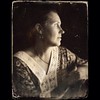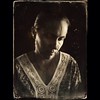
Essays
Virtual Enlightenment
A noise which epitomises youth in the 1990s is the sound which pre-broadband era internet made when dialling up to connect to the World Wide Web. This distinctive series of beeps and hisses are practically engraved into my auditory canals. Every time I have looked at this group of ultramodern paintings by Trevor Jones, in preparation for these brief words on art historical contextualisation, this sound has frolicked on repeat around my head. I think this response, the triggering of a very specific audio-memory, is imperative to my perception of how these pictures fit into my vision of Scottish art history and, as I consider this said context, I hope to clarify to you precisely why this is so.
Before I met with Jones for the first time, I did not anticipate just how excited I would be when I left his studio that evening. When I saw the prototype for the pieces, I knew I was witnessing something absolutely revolutionary in terms of visual art in this country. Jones told me that the works did not have a title, but hinted that he had a desire to christen one of them after the portrait-painting powerhouse, Sir Henry Raeburn (1756-1823). As soon as he mentioned this, I had hoped that the provisional label would stick.
Raeburn painted the portraits of innovators of the Enlightenment period. He did not, however, simply leave us with records of what the prodigious thinkers and doers of the late-eighteenth century once looked like. In addition, he also captured the zeitgeist which motivated their wealth of productivity through the manner in which he painted. He achieved this through absorbing and understanding the philosophy of Thomas Reid (1710-1796). In particular, he noted Reid's hypothesises regarding how human beings perceive the world around them. A sentence from the philosopher's Inquiry into the Human Mind (1764) which is repeatedly quoted in order to explain Raeburn's motivation as an artist is as follows:
The visible appearance of an object is extremely different from the notion of it which experience teaches us to form by sight.
Inspired, Raeburn endeavoured to supply his viewer with fragments of a subject rather than a distinct final composition. He wanted his audience to mentally construct pictures themselves and so he did not dictate to them how they should see things based on his own discernment. Reid had taught him that perception in humans was certainly not a uniform experience and so he sought to eradicate this presumption in art. The product of this principal aim was the trademark style which Raeburn is celebrated for. Brushstrokes flow loosely and hastily together to create flurries of paint and diverse visual anchors. Eyes, as a result, are unable to rest on one single specific form. They are instead left vigorously vibrating and darting all around the canvas - trying to piece together a mental jigsaw as if they were scanning Raeburn's sitter in the flesh.
To me, these works by Jones, Raeburn, Nasmyth, Peploe and Eardley, appear in some way connected to Raeburn and Reid's original enlightened aesthetical code. Without the aid of a mobile scanning device, the subject at first seems impenetrable. Thick impressionist style brushstrokes evaporate to form a geometric grid pattern comprised of rectangular strands pursuing one another in an infinite game of cyber-Duck, Duck, Goose. With this observation, it could be said that visually they do not appear tuned-in. They do, after all, bear similar resemblance to the picture on a television set performing through an inferior signal. This is probably why they remind me of the din of dial-up internet, for both this noise and Jones' paintings are, essentially, a bridge to something else. The destination in each instance is the online world. Like Raeburn, Jones, therefore, does not dictate the finished artwork to his audience. He supplies visual stimuli and then it is up to us to produce something from it for ourselves.
With the rampant popularity of social media, it is now possible to contribute to a worldwide conversation through the employment of hash-tags in a post or an update. The most popular Twitter discussions of last year regarded #egypt, #tigerblood and #threewordstoliveby. Through using one of these tags you could let others know what you thought about each subject and, simultaneously, invite a response. When using the hash-tag #markofbeauty, viewers of these paintings will be able to offer comment regarding what they think about them, the exhibition they are part of and, also, the other pieces which are on display. This response, given the nature of online communication, could either be text or digital images or, alternatively, hyperlinks to information uploaded by others relevant to personal thoughts. Those scanning the QRs will be able to view all of this information on a section of the gallery's website to which the codes lead.
The painted QR codes are, therefore, rather like the loosely demarcated human subjects of Raeburn's paintings. A solid foundation is provided for the viewing party in each instance which they, subsequently, are required to build upon. Raeburn's artwork exists in the viewer's mind, whereas Jones' exists in the minds of many. It is for these reasons that I considered the initial title of the first painting in this series so apt. The fact the other three names, Nasmyth, Peploe and Eardley, were decided through means of a Facebook poll by people Jones has never met illustrates how collaborative this work is and underlines the fact that the paintings do not fully exist in reality, but, rather, have another life in human manipulated virtual reality. This, really, is why I find these works so fascinating. Jones, subconsciously motivated by Raeburn with regards to painting a subject which is not entirely physically there, has managed to bring the philosophy which once made our nation culturally prosperous up to speed and, whilst doing so, contributed to the inauguration of a brand new ultramodern chapter in the history of the art of this small, but forcefully talented, country.
Fern Insh, May 2012.
PhD Researcher
Aberdeen University
www.scottishartblog.com



